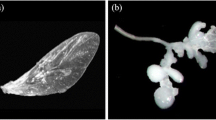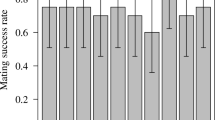Abstract
P2, the proportion of offspring sired by the second male to mate, is an indicator of the outcome of postcopulatory sexual selection, which occurs through sperm competition and/or cryptic female choice. We determined the appropriate dose of gamma radiation for sterilization of adult males and, using the sterile male technique, measured P2 in the adzuki bean beetle, Callosobruchus chinensis. Adult males of C. chinensis were almost completely sterilized when irradiated at 80 Gy. Thus, we obtained sterile males through irradiation at this dose. Neither the probability of female first mating nor the probability of female remating was affected by whether females were paired with normal or sterile males. The P2 calculated from the hatching success of eggs laid by females that mated both with normal and sterile males did not differ between reciprocal mating sequences, indicating that the sterilization has no effect on sperm fertilizing ability. The P2 was estimated at 0.25. This study shows that female remating in C. chinensis means the coexistence of sperm from two males and thus the occurrence of postcopulatory sexual selection within the female reproductive tract, resulting in first-male sperm precedence.

Similar content being viewed by others
References
Arnqvist G, Nilsson T, Katvala M (2005) Mating rate and fitness in female bean weevils. Behav Ecol 16:123–127
Birkhead TR, Møller AP (1998) Sperm competition and sexual selection. Academic, San Diego
Boorman E, Parker GA (1976) Sperm (ejaculate) competition in Drosophila melanogaster, and the reproductive value of females to males in relation to female age and mating status. Ecol Entomol 1:145–155
Brown DV, Eady PE (2001) Functional incompatibility between the fertilization systems of two allopatric populations of Callosobruchus maculatus (Coleoptera: Bruchidae). Evolution 55:2257–2262
Crudgington HS, Siva-Jothy MT (2000) Genital damage, kicking and early death. Nature 407:855–856
Darwin C (1871) The decent of man and selection in relation to sex. John Murray, London
Eady PE (1991) Sperm competition in Callosobruchus maculatus (Coleoptera: Bruchidae): a comparison of two methods used to estimate paternity. Ecol Entomol 16:45–53
Eady PE (1994) Intraspecific variation in sperm precedence in the bruchid beetle Callosobruchus maculatus. Ecol Entomol 19:11–16
Eady PE (1995) Why do male Callosobruchus maculatus males inseminate so many sperm? Behav Ecol Sociobiol 36:25–32
Eady PE, Rugman-Jones P, Brown DV (2004) Prior oviposition, female receptivity and last-male sperm precedence in the cosmopolitan pest Callosobruchus maculatus (Coleoptera : Bruchidae). Anim Behav 67:559–565
Eady PE, Hamilton L, Lyons RE (2007) Copulation, genital damage and early death in Callosobruchus maculatus. Proc R Soc Lond B 274:247–252
Eberhard WG (1996) Female control: sexual selection by cryptic female choice. Princeton University Press, Princeton
Edvardsson M, Tregenza T (2005) Why do male Callosobruchus maculatus harm their mates? Behav Ecol 16:788–793
Fox CW (1993) Multiple mating, lifetime fecundity and female mortality of the bruchid beetle, Callosobruchus maculatus (Coleoptera: Bruchidae). Funct Ecol 7:203–208
Fox CW, Hickman DL, Raleigh EL, Mousseau TA (1995) Paternal investment in a seed beetle (Coleoptera: Bruchidae): influence of male size, age, and mating history. Ann Entomol Soc Am 88:100–103
Gwynne DT (1984) Male mating effort, confidence of paternity and insect sperm competition. In: Smith RL (eds) Sperm competition and the evolution of animal mating systems. Academic, New York, pp 117–149
Harano T, Miyatake T (2005) Heritable variation in polyandry in Callosobruchus chinensis. Anim Behav 70:299–304
Harano T, Miyatake T (2007) Interpopulation variation in female remating is attributable to female and male effects in Callosobruchus chinensis. J Ethol 25:49–55
Harano T, Yasui Y, Miyatake T (2006a) Direct effects of polyandry on female fitness in Callosobruchus chinensis. Anim Behav 71:539–548
Harano T, Fujisawa M, Miyatake T (2006b) Effect of oviposition substrate on female remating in Callosobruchus chinensis (Coleoptera: Bruchidae). Appl Entomol Zool 41:569–572
Hussain T, Imura O (1989) Effects of gamma radiation on survival and reproduction of Callosobruchus chinensis (L.) (Coleoptera : Bruchidae). Appl Entomol Zool 24:273–280
Kraaijeveld K, Chapman T (2004) Effects of male sterility on female remating in the Mediterranean fruit fly, Ceratitis capitata. Proc R Soc Lond B 271:S209–S211
Kiritani K (1961) The origin of household pests, and the process of adaptation to indoor conditions (in Japanese). Seitai Kontyu 9:22–40
Miyatake T, Matsumura F (2004) Intra-specific variation in female remating in Callosobruchus chinensis and C. maculatus. J Insect Physiol 50:403–408
Parker GA (1970) Sperm competition and its evolutionary consequences in the insects. Biol Rev 45:525–567
Ridley M (1989) The incidence of sperm displacement in insects: four conjectures, one corroboration. Biol J Linn Soc 38:349–367
Rönn J, Katvala M, Arnqvist G (2006) The costs of mating and egg production in Callosobruchus seed beetles. Anim Behav 72:335–342
Rugman-Jones PF, Eady PE (2001) The sterile male technique: a source of error in estimating levels of sperm precedence? Entomol Exp Appl 98:241–244
SAS Institute Inc. (2000) JMP4. SAS Institute, Cary
Savalli UM, Fox CW (1998) Genetic variation in paternal investment in a seed beetle. Anim Behav 56:953–961
Savalli UM, Fox CW (1999) The effect of male mating history on paternal investment, fecundity and female remating in the seed beetle Callosobruchus maculatus. Funct Ecol 13:169–177
Savalli UM, Czesak ME, Fox CW (2000) Paternal investment in the seed beetle, Callosobruchus maculatus (Coleoptera: Bruchidae): variation among populations. Ann Entomol Soc Am 93:1173–1178
Simmons LW (2001) Sperm competition and its evolutionary consequences in the insects. Princeton University Press, Princeton
Simmons LW, Siva-Jothy MT (1998) Sperm competition in insects: mechanisms and the potential for selection. In: Birkhead TR, Møller AP (eds) Sperm competition and sexual selection. Academic, San Diego, pp 341–434
Smith RL (1984) Sperm competition and the evolution of animal mating systems. Academic, New York
Takakura K (1999) Active female courtship behavior and male nutritional contribution to female fecundity in Bruchidius dorsalis (Fahraeus) (Coleoptera: Bruchidae). Res Popul Ecol 41:269–273
Takakura K (2001) Courtship-role-reversal in the bean weevil, Bruchidius dorsalis (Coleoptera: Bruchidae): interplay between male–male competition and cryptic female choice. Appl Entomol Zool 36:311–316
Thornhill R (1983) Cryptic female choice and its implications in the scorpionfly Harpobittacus nigriceps. Am Nat 122:765–788
Thornhill R, Alcock J (1983) The evolution of insect mating systems. Harvard University Press, Cambridge
Tseng HF, Yang RL, Lin C, Horng SB (2007) The function of multiple mating in oviposition and egg maturation in the seed beetle Callosobruchus maculatus. Physiol Entomol 32:150–156
Umeya K (1987) Biology of Bruchids (in Japanese). Tsukiji-Shokan, Tokyo
Umeya K, Shimizu K (1968) Studies on the comparative ecology of bean weevils. III. Effect of feeding on the life span and oviposition of the adult of three species of bean weevils (in Japanese). Res Bull Plant Prot Serv Jpn 5:39–49
Watanabe N (1991) Adzuki bean weevil and Cowpea weevil. In: Yushima K, Kamano S, Tamaki Y (eds) Rearing methods of insects (in Japanese). Nihon-shyokubutuboueki-kyokai, Tokyo, pp 270–274
Wilson N, Tubman SC, Eady PE, Robertson GR (1997) Female genotype affects male success in sperm competition. Proc R Soc Lond B 264:1491–1495
Wilson N, Tufton TJ, Eady PE (1999) The effect of single, double and triple matings on the lifetime fecundity of Callosobruchus analis and Callosobruchus maculatus (Colepotera: Bruchidae). J Insect Behav 12:295–306
Yamane T, Miyatake T (2005) Intra-specific variation in strategic ejaculation according to level of polyandry in Callosobruchus chinensis. J Insect Physiol 51:1240–1243
Yamane T, Miyatake T (2007) Strategic ejaculation and level of polyandry in Callosobruchus chinensis (Coleoptera: Bruchidae). J Ethol; DOI 10.1007/s10164-007-0051-2
Yanagi S, Miyatake T (2003) Costs of mating and egg production in female Callosobruchus chinensis. J Insect Physiol 49:823–827
Acknowledgments
We thank anonymous referees for valuable comments. This study was supported by a grant-in-aid for Scientific Research (KAKENHI 16370013 and 19370011) from the Ministry of Education, Culture, Sports, Science and Technology of Japan (to T.M.).
Author information
Authors and Affiliations
Corresponding author
About this article
Cite this article
Harano, T., Nakamoto, Y. & Miyatake, T. Sperm precedence in Callosobruchus chinensis estimated using the sterile male technique. J Ethol 26, 201–206 (2008). https://doi.org/10.1007/s10164-007-0067-7
Received:
Accepted:
Published:
Issue Date:
DOI: https://doi.org/10.1007/s10164-007-0067-7




